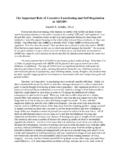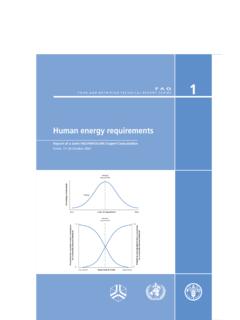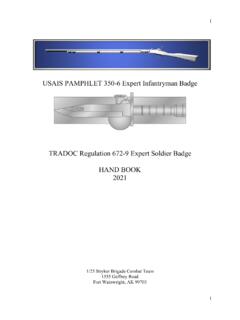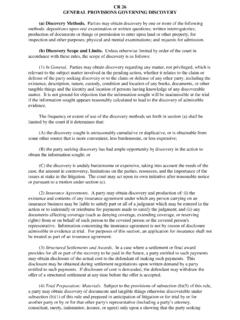Transcription of Fact Sheet: Attention Deficit Hyperactivity Disorder (ADHD ...
1 Fact Sheet: Attention Deficit Hyperactivity Disorder (ADHD) Topics MAJOR CHARACTERISTICS OTHER CHARACTERISTICS ADULT OUTCOME SUBTYPES PREVALENCE ETIOLOGIES TREATMENT MORE INFORMATION - SUGGESTED READINGS MORE INFORMATION - SUGGESTED READINGS FOR TEACHERS Attention - Deficit Hyperactivity Disorder (ADHD) is the current term for a specific developmental Disorder seen in both children and adults that is comprised of deficits in behavioral inhibition, sustained Attention and resistance to distraction, and the regulation of one s activity level to the demands of a situation ( Hyperactivity or restlessness).
2 This Disorder has had numerous different labels over the past century, including hyperactive child syndrome, hyperkinetic reaction of childhood, minimal brain dysfunction, and Attention Deficit Disorder (with or without Hyperactivity ). MAJOR CHARACTERISTICS The predominant features of this Disorder include: 1. Impaired response inhibition, impulse control, or the capacity to delay gratification. This is often noted in the individual s inability to stop and think before acting; to wait one s turn while playing games, conversing with others, or having to wait in line; to interrupt their responding quickly when it becomes evident that their actions are no longer effective; to resist distractions while concentrating or working; to work for larger, longer-term rewards rather than opting for smaller, more immediate ones; and inhibiting the dominant or immediate reaction to an event, as the situation may demand.
3 2. Excessive task-irrelevant activity or activity that is poorly regulated to the demands of a situation. Individuals with ADHD in many cases are noted to be excessively fidgety, restless, and on the go. They display excessive movement not required to complete a task, such as wriggling their feet and legs, tapping things, rocking while seated, or shifting their posture or position while performing relatively boring tasks. Younger children with the Disorder may show excessive running, climbing, and other gross motor activity.
4 While this tends to decline with age, even teenagers with ADHD are more restless and fidgety than their peers. In adults with the Disorder , this restlessness may be more subjective than outwardly observable, although with some adults they remain outwardly restless as well and report a new to always be busy or doing something and being unable to sit still. 3. Poor sustained Attention or persistence of effort to tasks. This problem often arises when the individual is assigned boring, tedious, protracted, or repetitive activities that lack intrinsic appeal to the person.
5 They often fail to show the same level of persistence, stick-to-it-tiveness, motivation, and will-power of others their age when uninteresting yet important tasks must be performed. They often report becoming easily bored with such tasks and consequently shift from one uncompleted activity to another without completing these activities. Loss of concentration during tedious, boring, or protracted tasks is commonplace, as is an inability to return to their task on which they were working should they be unexpectedly interrupted.
6 Thus, they are easily distracted during periods when concentration is important to the task at hand. They may also have problems with completing routine assignments without direct supervision, being unable to stay on task during independent work. These are the three most common areas of difficulty associated with ADHD. However, research is suggesting that those with ADHD, particularly the subtypes associated with impulsive behavior (see below), may also have difficulties in the following areas of psychological functioning as well: 1.
7 Remembering to do things, or working memory. Working memory refers to the capacity to hold information in mind that will be used to guide one s actions, either now, or at a later time. It is essential for remembering to do things in the near future. Those with ADHD often have difficulties with working memory and so are described as forgetful around doing things, unable to keep important information in mind that they will need to guide their actions later, and disorganized in their thinking and other activities as they often lose track of the goal of their activities.
8 They may often be described as acting without hindsight or forethought, and being less able to anticipate and prepare for future events as well as others, all of which seem to be dependent on working memory. Recently, research suggests that those with ADHD cannot sense or use time as adequately as others in their daily activities, such that they are often late for appointments and deadlines, ill-prepared for upcoming activities, and less able to pursue long-term goals and plans as well as others. Problems with time management and organizing themselves for upcoming events are commonplace in older children and adults with the Disorder .
9 2. Delayed development of internal language (the mind s voice) and rule-following. Research has lately been suggesting that children with ADHD are significantly delayed in the development of internal language, the private voice inside one s mind that we employ to converse with ourselves, contemplate events, and direct or command our own behavior. This private speech is absolutely essential to the normal development of contemplation, reflection, and self-regulation. Its delay in those with ADHD contributes to significant problems with their ability to follow through on rules and instructions, to read and follow directions carefully, to follow through on their own plans, rules, and do-lists, and even to act with legal or moral principles in mind.
10 When combined with their difficulties with working memory, this problem with self-talk or private speech often results in significant interference with reading comprehension, especially of complex, uninteresting, or extended reading assignments. 3. Difficulties with regulation of emotions, motivation, and arousal. Children and adults with ADHD often have problems inhibiting their emotional reactions to events as well as do others of their age. It is not that the emotions they experience are inappropriate, but that those with ADHD are more likely to publicly manifest the emotions they experience than would someone else.









